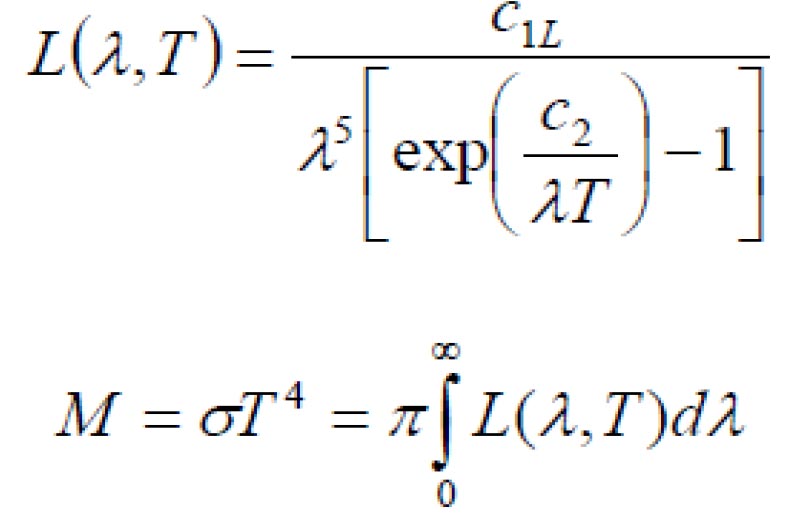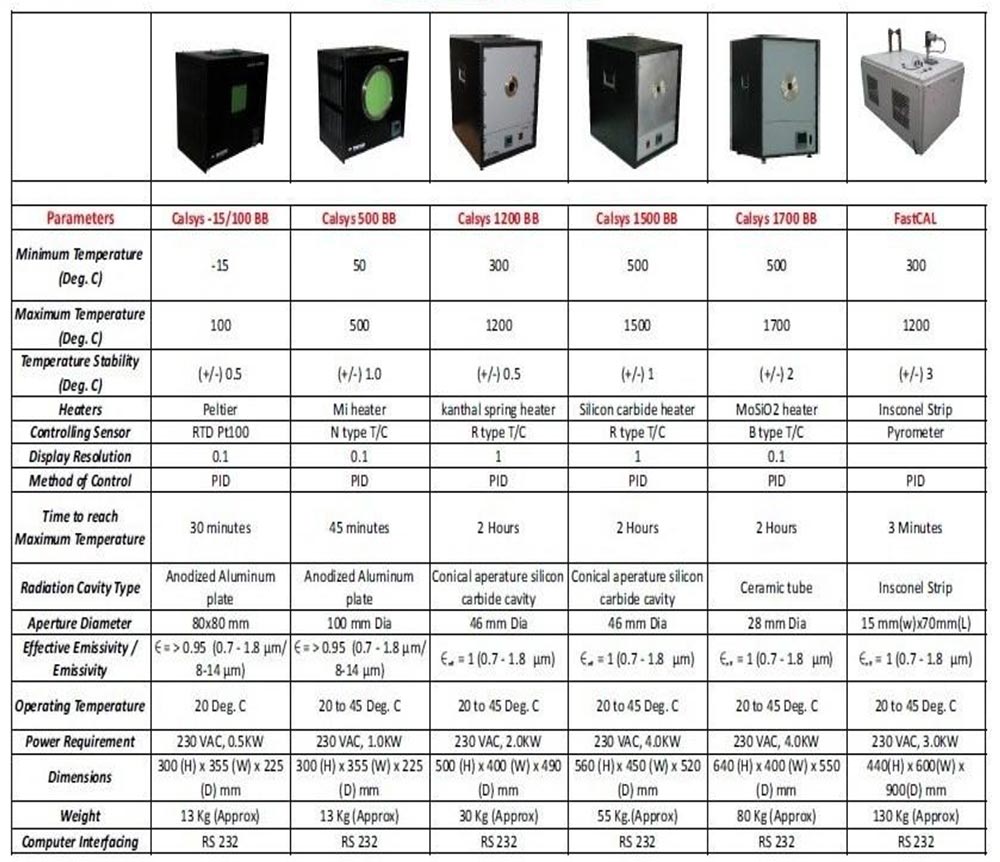- Home
- About
- Products
- Contact Temperature Sensors
- Cables & Wires
- Mineral Insulated Cables
- Nickel & Thermocouple Alloy
- Industrial Heaters
- Heating Cables and Mats
- Non Contact Temperature Sensors
- Industrial and R&D Furnaces
- Temperature Calibrators
-
Circulating Chiller
- Services
-
Special Products
- Thermal Profiling System
- Industries
- Resources
- Contact Us
- Shop
Black Body Calibrator
Black Body is the most ideal calibrator of an infrared thermometer. This is because blackbodies have an Emissivity equal to 1.000.
A perfect blackbody only would have an emissivity of 1.000. This would take place in a system where no light or radiation could escape and all the radiation shall remain inside forever. In the real world, there is no such thing as a perfect blackbody for IR thermometry. This is because there would be no opening for taking a measurement in such a system. However, the perfect blackbody is a good prototype for modeling thermal radiation.
Emissivity is the ratio of energy radiated by a particular material to energy radiated by a black body at the same temperature. A true black body would have an emissivity = 1 while any real object would have emissivity < 1. Emissivity is a dimensionless quantity. Every material radiates energy. The amount of radiated power is dependent on the material’s temperature and the material’s emissivity.
IR thermometers make use of this. They measure the amount of energy radiated by an object in an infrared band. This infrared band can vary from 1 micro meter to 14 micro meters. Depending on the wavelength range IR thermometers uses different types of sensors to determine the temperature. They calculate temperature based on this measured power and the material’s emissivity.
Emissivity is one of the major sources of error in infrared measurements. Knowledge of the emissivity of the measured surface is of great value to any user of an IR thermometer. As so, great care should be taken to know the effects of emissivity of the surface when measuring it. Deviation in the assumed emissivity of the measuring target body would lead to significant error in temperature measurement. Proper knowledge of emissivity and background temperature should be considered when measuring a surface temperature. These factors are even more important when using an IR thermometer calibrator. Paying attention to these factors will provide a better calibration and better IR metrology.
Planck’s Law
The mathematical equation describing the spectral power radiated by a perfect blackbody for a given wavelength is Planck's Law. If Planck's Law is integrated over the entire electro-magnetic spectrum, this gives us the Stefan-Boltzmann Law. This is the familiar T to the 4th law (T4). The problem with the Stefan- Boltzmann Law is that it is not limited to a specific band. To get such a number, we would need to integrate Planck's Law for the limits of this bandwidth. This integral cannot be solved analytically.
Cavities
Practically, there is no such thing as perfect blackbody in real world. Manufactures of Black bodies make different shapes and geometries which can be used or which can act as near perfect blackbody. A near perfect Black Body will have its emissivity close to 1 but not exactly equal to 1. A good approximation of a perfect blackbody is a cavity. A cavity can have different shapes; it can be a sphere, cylinder, cone or a combination of these. It must have a well controlled uniform temperature on its surfaces. The total emissivity of a cavity depends on its geometry, but is generally close to 1.000. Cavities will typically have an emissivity of 0.99, 0.999 etc. In simple terms we can understand that as emissivity is more close to 1, it acts as a better approximation for a perfect Black Body. A cavity is not always the best for all types of IR thermometers, especially handheld instruments. This is due to the optical scheme of these instruments. For an error free measurement the spot size of the IR thermometer should lie inside the radiating area. The spot size is the amount of area the IR thermometer sees when measuring temperature on a surface. Surface Black bodies are made which have a large surface area radiating energy and the whole surface is very uniform in terms of temperature and emissivity.
Error caused by Emissivity
Emissivity contributes to uncertainty when using a surface Black Body. If the user doesn’t have proper knowledge of the emissivity of the surface then emissivity can be a major contributor in the error caused in the temperature measurement. Users of these Black Body or IR Calibrators should have a standard chart about the emissivity of the surface material used. If the assumed emissivity of the Black Body is different from the actual emissivity of the surface then it can cause significant error in the temperature measurement. For example, if the emissivity of the surface of the calibrator is 0.93, and it is assumed as being 0.95, this will cause an error of 6.6°C at a surface temperature of 500°C when measuring in the 8 – 14 μm band.
Effect of Wavelength
Many charts can be found which lists the emissivity of various materials. These are good guides when looking for emissive properties of materials, but they do not tell us the correct value always because most material’s emissivity varies with wavelength. In other words, materials have a spectral emissivity response. An IR thermometer integrates the emissivity within its bandwidth. One study showed that the emissivity in the 8 - 14μm band varied between 0.90 and 0.97 with a dependence on wavelength. Other studies show a similar range of emissivities. Effect of Temperature Emissivity can also vary with temperature. The other effect that temperature can have is as temperature changes, the amount of energy measure by the IR thermometer shifts within the band. As temperature rises, the energy emitted by the surface shifts from the higher to the lower wavelengths as predicted by the Wien's Displacement Law. This causes the effective emissivity the IR thermometer measures to shift from that of the higher end of the bandwidth to that of the lower end as temperature rises.
Handling of Black Bodies
When using a Black body, care must be taken not to damage the emissive surface. Damage can result from a number of sources. First, care must be taken not to
get any foreign material on the surface of the calibrator. Even oil from your skin can damage the calibrator’s surface, especially when the surface is heated. The surface should not be cooled by any method other than natural convection. Forced air can often have oil or water in it. Even water can leave mineral deposits on the surface. Trying to cool the surface too quickly can also cause thermal shock to the emissive surface. The calibrator should not be left at a high temperature for an extended period of time.
This can cause the emissivity of the surface to be degraded.
Effect of Background
The other effect that emissivity has is that of background temperature. If an opaque surface has an emissivity of 0.9, this means that 10% of the energy is reflected as predicted by Kirchoff’s Law. This 10% is dependent on the temperature of surfaces that are facing the measured surface. This temperature is called background temperature. There is a slight uncertainty caused by background temperature. It is not much of a concern when measuring higher temperatures. However, it becomes a concern at lower temperatures. Some of this error is negated if the IR temperature is a surface at 0°C measured in the 8 – 14 μm band. If the user of the IR thermometer is standing facing the target, the user could very well become the background. This could raise the background from 23°C to 37°C causing a 3.5°C error in the measurement.
Black Body Product Chart
The Black Bodies available with us for different temperature ranges are as follows:
Black Body Furnaces



